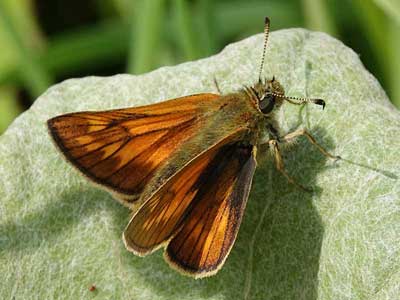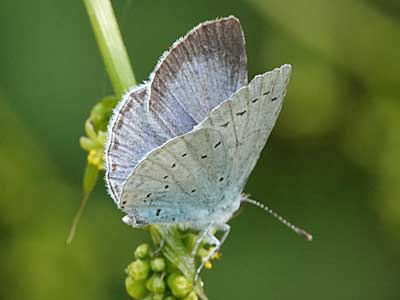Butterflies
The images below show the butterflies likely to be found in the Countryside Park.
Some, the Peacock, Comma and Small Tortoiseshell, overwinter as an adult so may be seen for most of the year. Other residents spend the winter months as a caterpillar or a chrysalis only emerging in the spring or summer. The Clouded Yellow and the Painted Lady are migrants whose numbers vary each year according to weather conditions both here and abroad, as is the Red Admiral although a few of these seem to overwinter here too.
Small/Essex Skipper

Small Skippers and Essex Skippers are almost identical. You need to see the underside of the tips of the antennae – orange for Small, black for Essex.
Large Skipper

The Large Skipper has more darker colouring on the wings, giving it a dirtier look than the other skippers seen in the valley.
Orange-tip (male)

The Orange-tip is a springtime butterfly which will have come and gone by the end of June. Only the male has the orange tips but the underside of the wings is unmistakable in both sexes.
Large White

A common sight throughout the summer, the large White can be identified by the solid black markings on it’s wing-tips that extend half-way down the forewings.
Small White

Also very common is the Small White which differs from the Large white in that it has grey markings confined to the forewing-tips.
Green-veined White

The wings of the Green-veined White have a more veined appearance, especially the undersides, and the grey patches at the wing-tips are not continuous.
Clouded Yellow

A very distinctive butterfly that is always a delight to see, although it is never here in large numbers. The most likely time to see them is in August although they often remain well into October.
Speckled Wood

Common through out the spring and summer the Speckled Wood is sure to be found along hedgerows and woodland paths.
Ringlet

The Ringlet is not very common in the Park and has a short season, so you are most likely to see it during July or early August.
Meadow Brown

A very common butterfly during the summer, the Meadow Brown can be identified by the black spots on the underwing and the usually single white spot in the eye on the forewing.
Gatekeeper

Another very common butterfly, the Gatekeeper has white spots on the rear wings and usually two white spots in the black eye spot.
Red Admiral

A few Red Admirals overwinter here but the majority of those seen are migrants.
Peacock

Probably our most recognisable butterfly, the Peacock uses the ‘eyes’ on its wings as a very effective defence mechanism.
Painted Lady

The Painted Lady is famed for the fact that it migrates all the way from Africa and many travel much further north than here.
Small Tortoiseshell

The Small Tortoiseshell can be seen throughout the spring and summer but in far smaller numbers than used to be the case.
Comma

The Comma is fairly common in the Park and is recognised by its colouring and ragged wing shape. However the undersides are a pattern of browns and give excellent camouflage.
Small Copper

Not often seen in the Park, the Small Copper is a very pretty small brown butterfly.
Brown Argus

With its wings closed it can be mistaken for a Common Blue as the wing pattern is very similar. However, the upper wing colour is very different and the Brown Argus is uncommon in the Park.
Common Blue (male)

Distinctly blue in flight, the Common Blue is the most numerous of the ‘blues’ in the Park. It prefers open grassland and low vegetation.
Common Blue (female)

The female has more patterning on the upper sides of its wings.
Holly Blue

The other butterfly seen in the Park that appears blue in flight is the Holly Blue but this has different underwings and is seen less often.
Although some butterflies overwinter as adults and can be seen earlier in the year, April is when many of them will start to emerge from the chrysalis stage. The Orange-tip is one of the first to appear and as it only has one brood each year most of them will be gone by June. Other species, such as the blues, the whites and the Speckled Wood, have two or three broods and can be seen for much longer. Some of our more numerous butterflies, like the Meadow Brown and the Gatekeeper, appear later in the summer, peaking in July and August.
More Information
More information about the butterflies found across Sussex can be found at the website of the Sussex branch of Butterfly Conservation.
Even more information and handy butterfly and moth identification pages can be found on the main Butterfly Conservation website.
Butterflies UK is a useful facebook group (one of several) and Butterfly Conservation in Sussex have a facebook page.
A book about Sussex butterflies is “The Butterflies of Sussex” by Michael Blencowe and Neil Hulme (2017).
A good field guide is “Britain’s Butterflies” from the “Wild Guides” series.
Photos on this page by Peter Hunnisett

